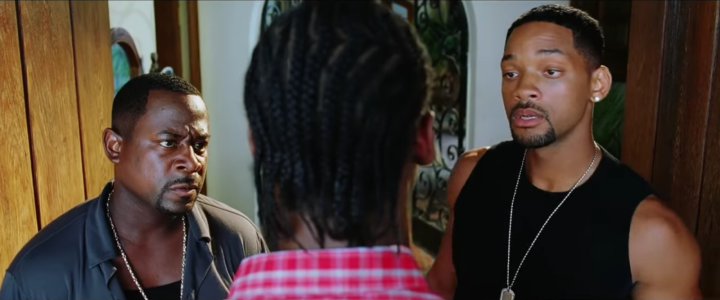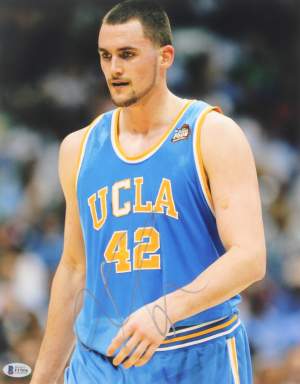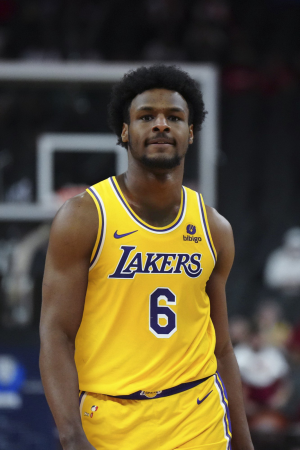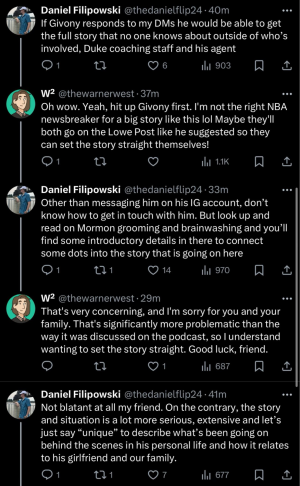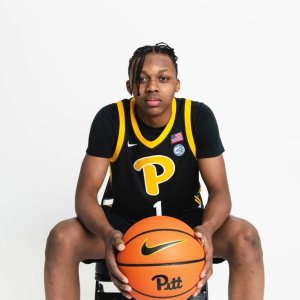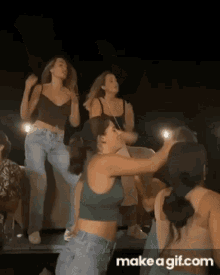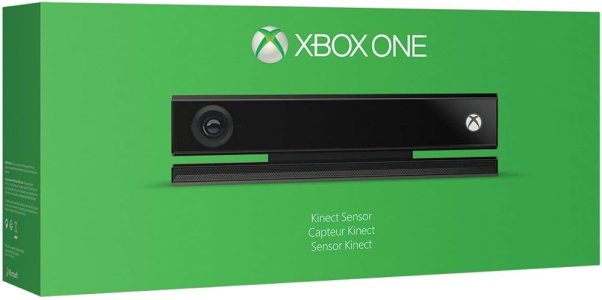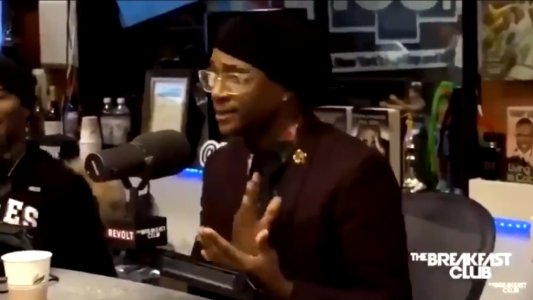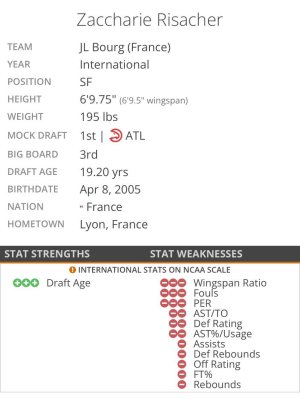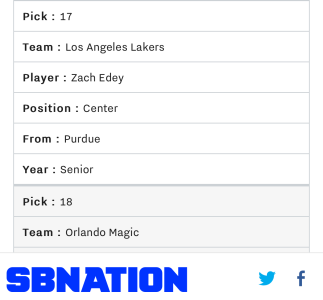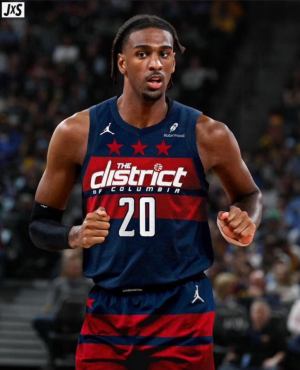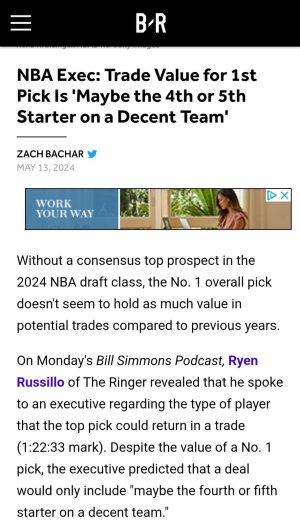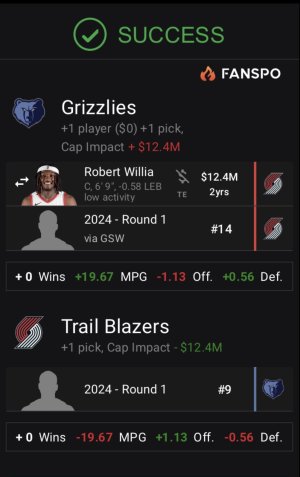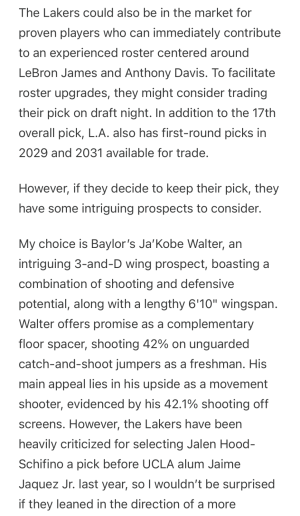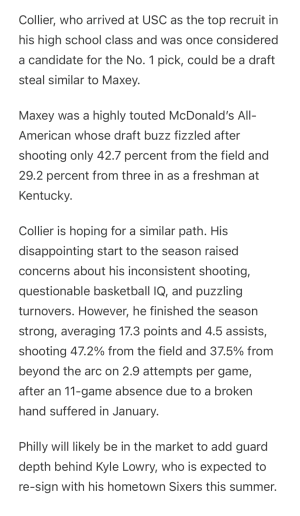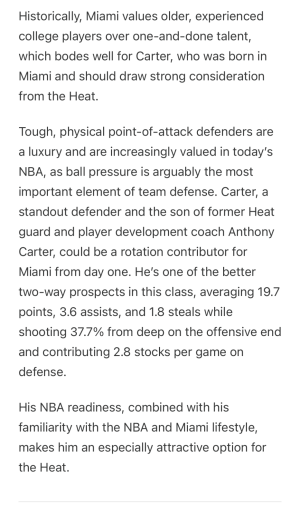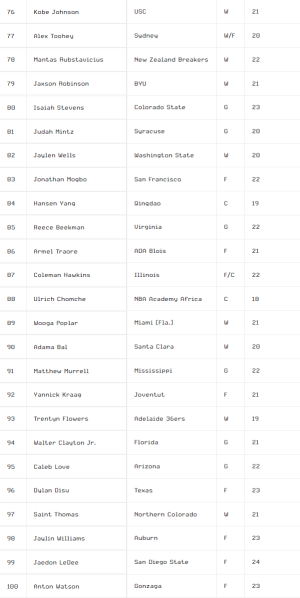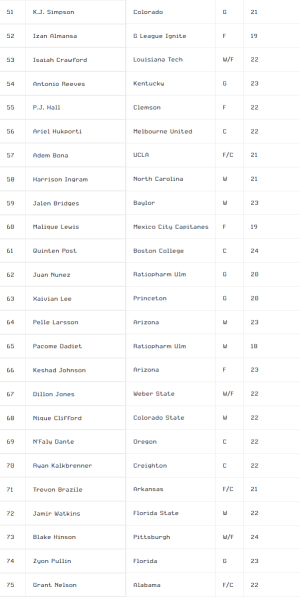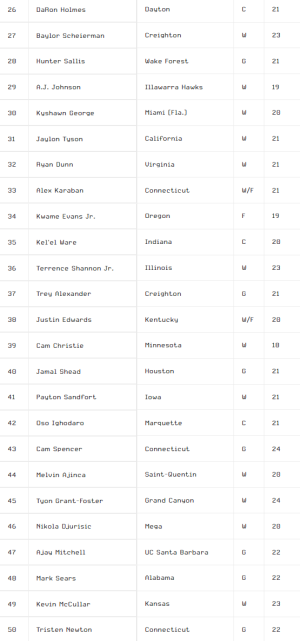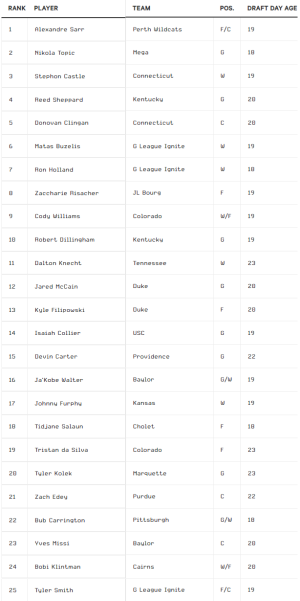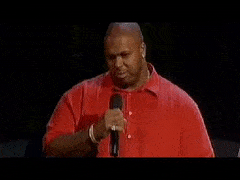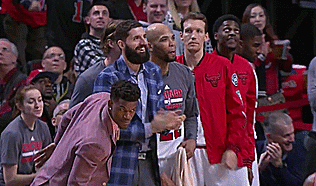- Sep 5, 2010
- 93,231
- 129,857
From a month ago:
Who's No. 1 between Cooper Flagg, Cameron Boozer and A.J. Dybantsa?
For high school seniors, the summer after their junior year is when their recruiting class officially takes center stage. In the spring, college coaches and fans are preoccupied with the transfer portal and the shuffling of rosters. But come summer, these players move into focus.
This month, though, it would be easy to forget the 2024 class is technically the next group in line. That's because the three best prospects in all of high school basketball -- Cooper Flagg, Cameron Boozer and A.J. Dybantsa -- are in the 2025 and 2026 classes. They had the stat lines that went viral and the games that drew the most eyeballs at last week's Nike's EYBL Peach Jam in North Augusta, South Carolina.
Boozer was the top-ranked player in the 2025 class -- and the No. 1 player regardless of class -- entering the summer; Flagg was No. 2 in both groups before putting forth one of the most dominant all-around performances we've seen at the elite youth basketball event; and Dybantsa, the No. 1 player in the 2026 class, led the Peach Jam in scoring, despite playing up two age groups.
What makes this trio even more intriguing is the age factor. Boozer won't turn 16 years old until next week. Flagg is 16 and seven months, and Dybantsa is five weeks younger than him. Flagg is widely rumored to be considering a reclassification into the 2024 class, and Dybantsa could potentially eye a move into the 2025 class. And Boozer and Flagg played on the Nike circuit in the 16U division, with Dybantsa playing in the 17s.
But there's a chance that Boozer, Flagg and Dybantsa -- three of the best prospects in recent memory -- could all be in the same high school (and NBA draft) class.
So who is the best of the group? We asked 20 college coaches and NBA scouts for their rankings and thoughts on the Flagg-Boozer-Dybantsa pecking order.
1. Cooper Flagg (12 first-place votes)
This was a landslide victory for Flagg, who garnered a majority of the first-place votes and didn't finish below second on any of the other ballots. While much of this can be attributed to recency bias, it's hard to ignore what he did over the past two weeks.
Flagg has been a social media sensation for some time, but his exploits last week at the Peach Jam took his reputation to an entirely new level. He put up video game numbers seemingly every day, notching seven double-doubles and three triple-doubles in seven games. Included were two all-time performances: 38 points, 16 rebounds, 6 assists and 12 blocks against Pro Skills; and 37 points, 12 rebounds, 6 assists and 10 blocks against New Heights Lightning in the playoffs. All this came after he was named MVP at the prestigious National Basketball Players Association Top 100 Camp in Orlando, Florida, in late June.
"Flagg is just different," an NBA scout said. "He has the mental makeup. Silent killer, assassin. He's consistent with his mindset, motor and production. If he doesn't develop an ounce of his offensive package from this day forward, he's still potentially in the running for a defensive player of the year at the NBA level. Just the progressions that he's shown with the live ball playmaking, shot-creating off the bounce, instinctive reads and plays on both ends and then how he carries himself. Not like the other two are not, but he has a chance to be a transformational basketball player in the sport as a whole."
"Flagg is the most complete player," one college coach said. "He does it on both ends of the floor. Excellent passer. Basically can play 1 through 4 on both ends of the floor. He plays hard, never takes any plays off. His biggest weakness right now is his perimeter shooting -- which is still pretty good."
Flagg finished the Peach Jam with averages of 25.4 points (third in the 16U division), 13.0 rebounds (second), 5.7 assists (second) and 6.9 blocks (second) per game, while his spring and summer numbers were 26.9 PPG (second), 11.9 RPG (second), 4.7 APG (tied for seventh) and 4.5 BPG (first).
"Cooper impacts the game in more ways than the other two," another NBA scout said. "He's both a ceiling and floor raiser. He's easily the most impactful defensive prospect of the three."
"Flagg is the more dynamic defender and passer of the three," a college coach added. "He impacts winning in more ways than those other two right now."
The 6-foot-8 forward from Maine plays his high school ball at Florida's Montverde Academy. He plays two completely different styles on the grassroots and high school circuit. With Maine United, he is the focal point of everything his team does. Flagg is on the court every minute: He brings the ball up, creates offense for his teammates, gets his own shot on a majority of possessions and attempts to block every shot.
When he is with Montverde, he is part of a far more talented group (there were four other five-star prospects on the team last season), and his numbers aren't nearly as otherworldly. In 25 games for Monteverde, Flagg averaged fewer than 18 minutes per game, totaling 9.8 PPG, 5.2 RPG, 3.0 APG and 2.2 BPG.
"Flagg is No. 1 because of his defense and his swag," a college coach said. "He's such a polished player with very few holes in his game, and he knows it."
"Cooper Flagg is what a modern-day wing looks like in the NBA," another coach added. "Long, athletic, versatile and can dribble, pass and shoot. I think the intensity and competitiveness he plays with will translate really smooth to the next level."
2. A.J. Dybantsa (seven first-place votes)
What had been a two-man "Boozer or Flagg?" debate for much of the past year was turned into a three-man affair with Dybantsa's scoring exploits on the Nike EYBL circuit in the spring and summer then his eye-opening offensive performances on the biggest stage at the Peach Jam. Dybantsa earned a sizable share of first-place votes, and he was lower than second on just four of the other ballots.
Despite playing up two age groups (really just one, because he turned 16 in January; but two grade levels) with the Expressions program, Dybantsa led the Peach Jam in scoring -- by some distance. He averaged 25.8 PPG in five games in North Augusta, including 32 points against Paul George Elite and 31 points against Boo Williams. He got to the free throw line nearly 10 times per game, highlighted by 17 attempts in the game against Boo Williams.
"Dybantsa is more in the mold of what the elite NBA players typically look like," one coach said. "Versatile guards in that 6-foot-6 [to] 6-foot-8 range that you build your franchise around. Kobe [Bryant], [Tracy] McGrady, [Grant] Hill, [Jayson] Tatum, Kawhi [Leonard], Paul George. He has the potential to be in that mold."
That's one thing that kept coming up in conversations with scouts and coaches: how Dybantsa's status as a 6-foot-8 wing scorer is more in line with what we traditionally see from high-level stars at the NBA level. Interestingly, one college coach noted the exact opposite, pointing to do-everything frontcourt players like Giannis Antetokounmpo, Nikola Jokic and Joel Embiid as recent MVPs.
"Ten years ago, he would be No. 1 on this. His size and length. He has switchability on defense," the coach said of Dybantsa. "It's just the way the game is trending: positionless. The other two you can do so many creative things with."
The other plus in Dybantsa's column? He did it at the 17U level.
"I can't recall a sophomore averaging 26 a game and leading the 17U Peach Jam in scoring," a veteran head coach said.
"A.J. is what the NBA is right now," a coach said. "Flagg wouldn't have led 17U in scoring. A.J. is going to get physically stronger too."
"Dybantsa is just the most complete," another one added. "Scores at all three levels. Super athletic. He's the No. 1 pick in the NBA draft whenever he goes."
Dybantsa, like Boozer, started all six games at the FIBA U16 Americas Championship, where he averaged 13.7 PPG, 3.7 RPG and 3.8 APG while shooting 69.4% inside the arc. He also blew away the competition in scoring at the NBPA Top 100 Camp, averaging 28.3 PPG in six games in Orlando, shooting 70.5% on 2s and 30.8% from behind the arc.
"Dybantsa is obviously very talented," a college coach said. "He just needs to continue to work on his perimeter shooting, which will come with time. Knowing which shots to take and which ones to pass up. I was extremely impressed with his talking ability. He communicates on both ends of the floor at a high level."
Next, the Brockton, Massachusetts, native will head out to California to attend and play for Prolific Prep this school year.
3. Cameron Boozer (one first-place vote)
"I feel like a criminal ranking Boozer third," one coach admitted.
Boozer entered July as the No. 1 player in the 2025 class and the No. 1 prospect in all of high school basketball. Had this poll been done before Peach Jam, there's a strong chance Boozer would have ranked No. 1. Instead, he only garnered one first-place vote, even though he is the youngest of the three and multiple coaches and scouts said he would be the top pick to play a college game today.
The son of former Duke and NBA star Carlos Boozer, Cameron has been consistently dominant throughout his career thus far. During the regular season of the EYBL 16U, he averaged 24.9 PPG (third) and 13.2 RPG (first), before leading USA Basketball to the gold medal in the FIBA U16 Americas. In six international games, Boozer put up 16.8 PPG and 9.8 RPG, including 24 points and 12 boards in the gold-medal win over Canada.
"Boozer is really good and could step foot into any college basketball practice in the country and be able to be one of the best two or three players on any team -- as a 2025 recruit," one coach said.
But the gap between Boozer and the other two of this trio clearly narrowed at the Peach Jam, as Boozer struggled with foul trouble and made just 21.7% of his 3-point attempts in seven games. He still managed to average 15.4 PPG, 10.9 RPG and 5.1 APG, but he finished with just five points and seven rebounds in the championship game win over Flagg and Maine United.
"I know Flagg won the first matchup, but I've seen both him and Cam a lot -- and I think Cam is the better NBA talent," one head coach said. "Cam shoots it better and plays with incredible pace and patience. Cooper is fantastic, obviously, but relies on his athleticism at this level a little more. He will be more 'normal' that way in the NBA."
"I've seen Boozer look like the best of the bunch at NBPA Top 100," another coach added. "Watch his game vs. Cooper at Top 100. Incredible."
A 6-foot-9 power forward, Boozer plays alongside his twin brother, five-star point guard Cayden, on the AAU and high school circuits. Unlike Flagg, Cameron Boozer plays a similar role both with Nightrydas and at Florida's Christopher Columbus High School. Boozer does most of his damage around the rim, but he can handle the ball, can shoot consistently from the perimeter, is a versatile defender and has drawn comparisons to Kevin Love for his outlet passing ability.
"Don't get me wrong: I would love to have him, and he's probably an All-Star type of player too," one college coach said. "But he could also just be a very good player. I think those other two are real franchise guys."
For high school seniors, the summer after their junior year is when their recruiting class officially takes center stage. In the spring, college coaches and fans are preoccupied with the transfer portal and the shuffling of rosters. But come summer, these players move into focus.
This month, though, it would be easy to forget the 2024 class is technically the next group in line. That's because the three best prospects in all of high school basketball -- Cooper Flagg, Cameron Boozer and A.J. Dybantsa -- are in the 2025 and 2026 classes. They had the stat lines that went viral and the games that drew the most eyeballs at last week's Nike's EYBL Peach Jam in North Augusta, South Carolina.
Boozer was the top-ranked player in the 2025 class -- and the No. 1 player regardless of class -- entering the summer; Flagg was No. 2 in both groups before putting forth one of the most dominant all-around performances we've seen at the elite youth basketball event; and Dybantsa, the No. 1 player in the 2026 class, led the Peach Jam in scoring, despite playing up two age groups.
What makes this trio even more intriguing is the age factor. Boozer won't turn 16 years old until next week. Flagg is 16 and seven months, and Dybantsa is five weeks younger than him. Flagg is widely rumored to be considering a reclassification into the 2024 class, and Dybantsa could potentially eye a move into the 2025 class. And Boozer and Flagg played on the Nike circuit in the 16U division, with Dybantsa playing in the 17s.
But there's a chance that Boozer, Flagg and Dybantsa -- three of the best prospects in recent memory -- could all be in the same high school (and NBA draft) class.
So who is the best of the group? We asked 20 college coaches and NBA scouts for their rankings and thoughts on the Flagg-Boozer-Dybantsa pecking order.
1. Cooper Flagg (12 first-place votes)
This was a landslide victory for Flagg, who garnered a majority of the first-place votes and didn't finish below second on any of the other ballots. While much of this can be attributed to recency bias, it's hard to ignore what he did over the past two weeks.
Flagg has been a social media sensation for some time, but his exploits last week at the Peach Jam took his reputation to an entirely new level. He put up video game numbers seemingly every day, notching seven double-doubles and three triple-doubles in seven games. Included were two all-time performances: 38 points, 16 rebounds, 6 assists and 12 blocks against Pro Skills; and 37 points, 12 rebounds, 6 assists and 10 blocks against New Heights Lightning in the playoffs. All this came after he was named MVP at the prestigious National Basketball Players Association Top 100 Camp in Orlando, Florida, in late June.
"Flagg is just different," an NBA scout said. "He has the mental makeup. Silent killer, assassin. He's consistent with his mindset, motor and production. If he doesn't develop an ounce of his offensive package from this day forward, he's still potentially in the running for a defensive player of the year at the NBA level. Just the progressions that he's shown with the live ball playmaking, shot-creating off the bounce, instinctive reads and plays on both ends and then how he carries himself. Not like the other two are not, but he has a chance to be a transformational basketball player in the sport as a whole."
"Flagg is the most complete player," one college coach said. "He does it on both ends of the floor. Excellent passer. Basically can play 1 through 4 on both ends of the floor. He plays hard, never takes any plays off. His biggest weakness right now is his perimeter shooting -- which is still pretty good."
Flagg finished the Peach Jam with averages of 25.4 points (third in the 16U division), 13.0 rebounds (second), 5.7 assists (second) and 6.9 blocks (second) per game, while his spring and summer numbers were 26.9 PPG (second), 11.9 RPG (second), 4.7 APG (tied for seventh) and 4.5 BPG (first).
"Cooper impacts the game in more ways than the other two," another NBA scout said. "He's both a ceiling and floor raiser. He's easily the most impactful defensive prospect of the three."
"Flagg is the more dynamic defender and passer of the three," a college coach added. "He impacts winning in more ways than those other two right now."
The 6-foot-8 forward from Maine plays his high school ball at Florida's Montverde Academy. He plays two completely different styles on the grassroots and high school circuit. With Maine United, he is the focal point of everything his team does. Flagg is on the court every minute: He brings the ball up, creates offense for his teammates, gets his own shot on a majority of possessions and attempts to block every shot.
When he is with Montverde, he is part of a far more talented group (there were four other five-star prospects on the team last season), and his numbers aren't nearly as otherworldly. In 25 games for Monteverde, Flagg averaged fewer than 18 minutes per game, totaling 9.8 PPG, 5.2 RPG, 3.0 APG and 2.2 BPG.
"Flagg is No. 1 because of his defense and his swag," a college coach said. "He's such a polished player with very few holes in his game, and he knows it."
"Cooper Flagg is what a modern-day wing looks like in the NBA," another coach added. "Long, athletic, versatile and can dribble, pass and shoot. I think the intensity and competitiveness he plays with will translate really smooth to the next level."
2. A.J. Dybantsa (seven first-place votes)
What had been a two-man "Boozer or Flagg?" debate for much of the past year was turned into a three-man affair with Dybantsa's scoring exploits on the Nike EYBL circuit in the spring and summer then his eye-opening offensive performances on the biggest stage at the Peach Jam. Dybantsa earned a sizable share of first-place votes, and he was lower than second on just four of the other ballots.
Despite playing up two age groups (really just one, because he turned 16 in January; but two grade levels) with the Expressions program, Dybantsa led the Peach Jam in scoring -- by some distance. He averaged 25.8 PPG in five games in North Augusta, including 32 points against Paul George Elite and 31 points against Boo Williams. He got to the free throw line nearly 10 times per game, highlighted by 17 attempts in the game against Boo Williams.
"Dybantsa is more in the mold of what the elite NBA players typically look like," one coach said. "Versatile guards in that 6-foot-6 [to] 6-foot-8 range that you build your franchise around. Kobe [Bryant], [Tracy] McGrady, [Grant] Hill, [Jayson] Tatum, Kawhi [Leonard], Paul George. He has the potential to be in that mold."
That's one thing that kept coming up in conversations with scouts and coaches: how Dybantsa's status as a 6-foot-8 wing scorer is more in line with what we traditionally see from high-level stars at the NBA level. Interestingly, one college coach noted the exact opposite, pointing to do-everything frontcourt players like Giannis Antetokounmpo, Nikola Jokic and Joel Embiid as recent MVPs.
"Ten years ago, he would be No. 1 on this. His size and length. He has switchability on defense," the coach said of Dybantsa. "It's just the way the game is trending: positionless. The other two you can do so many creative things with."
The other plus in Dybantsa's column? He did it at the 17U level.
"I can't recall a sophomore averaging 26 a game and leading the 17U Peach Jam in scoring," a veteran head coach said.
"A.J. is what the NBA is right now," a coach said. "Flagg wouldn't have led 17U in scoring. A.J. is going to get physically stronger too."
"Dybantsa is just the most complete," another one added. "Scores at all three levels. Super athletic. He's the No. 1 pick in the NBA draft whenever he goes."
Dybantsa, like Boozer, started all six games at the FIBA U16 Americas Championship, where he averaged 13.7 PPG, 3.7 RPG and 3.8 APG while shooting 69.4% inside the arc. He also blew away the competition in scoring at the NBPA Top 100 Camp, averaging 28.3 PPG in six games in Orlando, shooting 70.5% on 2s and 30.8% from behind the arc.
"Dybantsa is obviously very talented," a college coach said. "He just needs to continue to work on his perimeter shooting, which will come with time. Knowing which shots to take and which ones to pass up. I was extremely impressed with his talking ability. He communicates on both ends of the floor at a high level."
Next, the Brockton, Massachusetts, native will head out to California to attend and play for Prolific Prep this school year.
3. Cameron Boozer (one first-place vote)
"I feel like a criminal ranking Boozer third," one coach admitted.
Boozer entered July as the No. 1 player in the 2025 class and the No. 1 prospect in all of high school basketball. Had this poll been done before Peach Jam, there's a strong chance Boozer would have ranked No. 1. Instead, he only garnered one first-place vote, even though he is the youngest of the three and multiple coaches and scouts said he would be the top pick to play a college game today.
The son of former Duke and NBA star Carlos Boozer, Cameron has been consistently dominant throughout his career thus far. During the regular season of the EYBL 16U, he averaged 24.9 PPG (third) and 13.2 RPG (first), before leading USA Basketball to the gold medal in the FIBA U16 Americas. In six international games, Boozer put up 16.8 PPG and 9.8 RPG, including 24 points and 12 boards in the gold-medal win over Canada.
"Boozer is really good and could step foot into any college basketball practice in the country and be able to be one of the best two or three players on any team -- as a 2025 recruit," one coach said.
But the gap between Boozer and the other two of this trio clearly narrowed at the Peach Jam, as Boozer struggled with foul trouble and made just 21.7% of his 3-point attempts in seven games. He still managed to average 15.4 PPG, 10.9 RPG and 5.1 APG, but he finished with just five points and seven rebounds in the championship game win over Flagg and Maine United.
"I know Flagg won the first matchup, but I've seen both him and Cam a lot -- and I think Cam is the better NBA talent," one head coach said. "Cam shoots it better and plays with incredible pace and patience. Cooper is fantastic, obviously, but relies on his athleticism at this level a little more. He will be more 'normal' that way in the NBA."
"I've seen Boozer look like the best of the bunch at NBPA Top 100," another coach added. "Watch his game vs. Cooper at Top 100. Incredible."
A 6-foot-9 power forward, Boozer plays alongside his twin brother, five-star point guard Cayden, on the AAU and high school circuits. Unlike Flagg, Cameron Boozer plays a similar role both with Nightrydas and at Florida's Christopher Columbus High School. Boozer does most of his damage around the rim, but he can handle the ball, can shoot consistently from the perimeter, is a versatile defender and has drawn comparisons to Kevin Love for his outlet passing ability.
"Don't get me wrong: I would love to have him, and he's probably an All-Star type of player too," one college coach said. "But he could also just be a very good player. I think those other two are real franchise guys."







